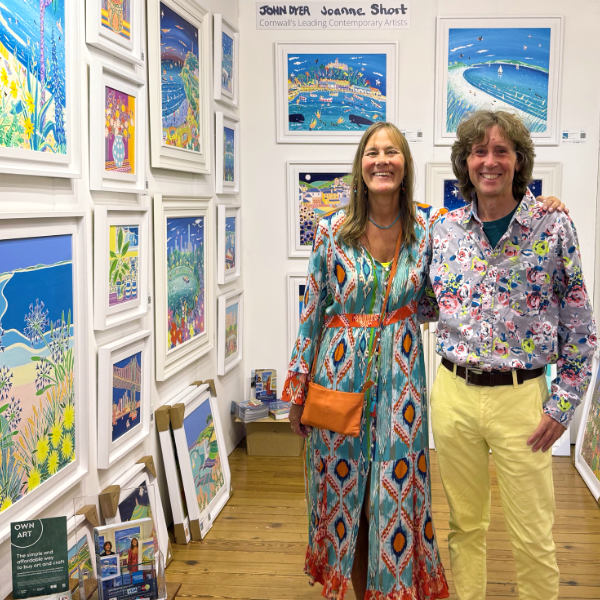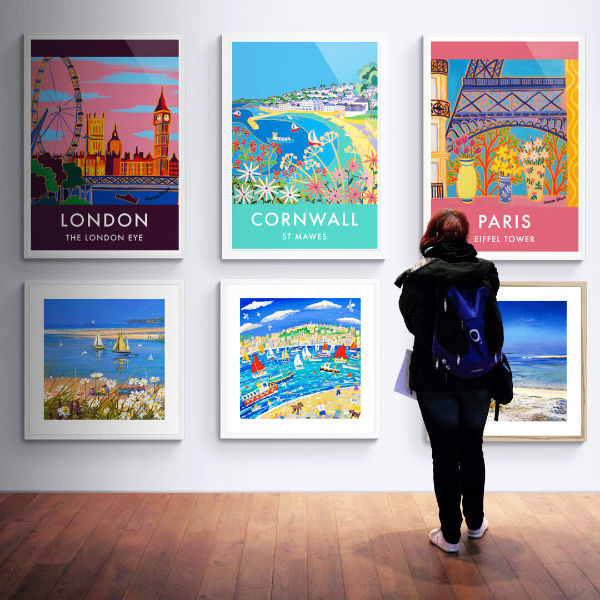Invest in British Art from Cornwall's Leading Artists | Free Worldwide Delivery
JOHN DYER
Original Paintings
New paintings available to buy online now by Cornwall's best loved artist.
JOANNE SHORT
Original Oil Paintings
New paintings available to buy online now by Cornwall's acclaimed colourist painter.
TED DYER
Original Oil Paintings
New paintings available to buy online by Cornwall's best known impressionist artist.
All Original Paintings
View all of the new original paintings that we have available to buy online now in our online gallery.
The ones you missed
View all of the recently sold original paintings by our Cornish artists John Dyer, Ted Dyer and Joanne Short.
Cornwall Art Prints
Museum-quality prints. Framed, Unframed, Signed & Wall Art Posters
Art T-Shirts, Hats & Hoodies designed in Cornwall. Eco-friendly. Free worldwide delivery.
Christmas Collection 2025
Stunning new painting collection by Cornish artists John Dyer & Joanne Short now available to view and buy.
Spirit of the Harvest | Eden Project
October 2025 - February 2026
New major John Dyer paintings inspired by global harvests, with field paintings from Peru, Costa Rica & the Philippines.
Colours of the South of France
New collection of French Riviera and Provence paintings by John Dyer opens on October 18th 2025.
Explore our Previous Exhibitions
Enjoy exploring our previous exhibitions online and discover extraordinary paintings you can own today.
Press Coverage and Testimonials
Art Collectors Club
Enjoy 5% off your first order, regular offers, exclusive exhibition invitations and artist and gallery updates in our email newsletter.
Artist John Dyer has been the artist in residence at the Eden Project in Cornwall from the year 2000 to the present day.
John Dyer's latest project with the Eden project is Last Chance to Paint which inspires children to connect to our planet using art.
Sign your school up for the amazing Last Chance to Paint art project so your children can 'travel', paint, exhibit and connect to the natural world with the Eden Project's artist in residence.
"A Fabulous collection which perfectly epitomises Eden."
Sir Tim Smit, KBE
Executive Chairman of Eden Project International and Co-Founder and Executive Vice Chair of Eden Project

"The Eden Project, an educational charity, connects us with each other and the living world exploring how we can work towards a better future. Eden was built as a symbol of optimism showing what can be done when people work together and with nature and shares stories of hope to inspire people to get involved in tackling some of today’s environmental challenges.Eden’s plants, exhibits and exhibitions celebrate our relationship with the natural world: our life-support system. Plants are our lifeblood. From blue jeans to coffee beans, plants feed us, clothe us and heal us. They colour the fabric of our lives and supply the very air we breathe. Eden is a living theatre of plants and people. Many players – artists, writers, sculptors, poets and storytellers – come to perform on Eden’s stage to help communicate the amazing stories about people’s relationship with nature and the vital importance of respecting and nurturing that which keeps us alive. John Dyer was already exploring the relationship between plants and people with his crop paintings from Provence when he was appointed as Eden’s painter in residence in 2000. From day one John embraced Eden’s mission and narrative with his optimistic paintings exploring plants, people and projects. He still works alongside Eden today, and we have been delighted to hold exhibitions of his paintings to share his vision and energy with a wide audience.As John discovered more about the plants, the crops and those who grew them, his interest in ethno-botany grew and he embarked on fascinating painting projects, with Eden’s assistance, with organisations in Peru, Australia, Costa Rica and the Philippines. More recently John’s interest has been captured by tribal culture, and his idea to invite Amazon Indian Nixiwaka Yawanawá, a guest of Survival International, to paint alongside him in our Rainforest Biome was inspired. The paintings resulting from this partnership shone a light on tribal culture, the beauty of the forest and its vital nature and the importance of tribes to the health and protection of the rainforests. It also uncovered a new genre of art. This was only the start: it was John's enthusiasm which inspired over a thousand children from around the world to take an active part in the project too and we were honoured and delighted to exhibit more than three hundred of their paintings in the Rainforest Biome. It has been a pleasure to work with John at Eden for the past 18 years, and we look forward to many fruitful partnerships in the future."
Dr Jo Elworthy. Director of Interpretation at the Eden Project
Tim Smit’s declaration that the Eden Project would be the ‘theatre of plants and people’ set the tone for the whole organisation. From the beginning, there was a real sense of the way in which artists, writers and performers could help Eden to achieve its vision by putting across its message in an accessible way. Eden’s Artistic Director, Sue Hill, says that they were actively seeking ‘artists who were outward-looking, socially engaged and curious – John ticked all those boxes’. Nor was this a one-way process. The experience of being at Eden at such a formative time in its evolution opened many doors for John and gave him a platform to share his creative vision with a wider audience.
By being involved in its exciting and productive early stages, John witnessed the amazing transformation of the Biomes from building sites to living, growing environments within the space of only a few months before they opened officially to the public. Having spent some weeks amongst the plants in the Watering Lane Nursery, John visited the Biomes for the first time in December 2000. Wearing the obligatory hard hat, he escaped the atrocious winter weather to arrive in ‘the steamy tropical atmosphere of West Africa, at the very top of the Humid Tropics Biome [now called Rainforest Biome]. I looked down through the Biome towards an oasis of palm trees planted next to a lagoon surrounded by earth-moving equipment and tiny people. The whole scene resembled a gigantic set from a James Bond film; teams of people busily working in fluorescent jackets and colour-coded hard hats, electric buggies ferrying plants and people through the Biome.’
John spent one day every week at Eden and between each visit would see dramatic changes to what Sue Hill has described as being like ‘the invention of a new world’: the construction of the waterfall, the planting of ‘almost vertical rock-faces’, and each week the addition of more and more spectacular plants, many of which seemed to have grown to full height overnight.‘The myriad of leaf shapes, twisted stems, prehistoric thorns and jewel-like tropical flowers, surrounded by busy people pushing wheelbarrows, moving soil and carrying enormous plants, has provided a truly exciting subject for me.’ The human factor was a vital component for John. Meeting and talking to the scientists and horticulturalists within the Biomes, and later to the many visitors who came to see this amazing creation, gave him an insight into the importance of learning about the way different plants and habitats actually affect people’s lives.
While the Humid Tropics Biome was replicating the sense of being within the steamy rainforests of the Amazon or tropical Africa, it was in the Warm Temperate Biome (later re-named the Mediterranean Biome, though it also houses many plants from the semi-drought areas of South Africa and California) that there was more of a focus on the edible plants typically grown in these drier regions. Gnarled old olive trees and vines jostle for space with citrus and peach trees, figs, aubergines, tomatoes and sunflowers, and the air is deliciously scented with lavender and rosemary.
The Eden Project was in one sense the complete opposite of Heligan; while one was bringing back to life a mature garden, with plants replaced only when diseased or dying, the other sought to create from scratch a fertile living environment on a post-industrial site where nothing had grown for years. John had known about this astonishing, visionary idea for a few years and was keen to be a part of it. He also knew that Tim Smit, originator of the project, wanted artists to be very much involved in its development from the beginning, as he believed an arts-driven culture would help to communicate its message about the vital relationship between plants and people and the importance of creating resources for a sustainable future.
John contacted Sue Hill, Eden’s Artistic Director, and in November 2000 was offered a painting residency by her; later she paid tribute to the way John had ‘charmed staff and public alike with his interest and enthusiasm’, making him an ideal communicator. John’s first sight of the plants which would be grown in the Humid Tropics (now Rainforest) Biome and the Warm Temperate Biome (now Mediterranean) was not at Eden itself, as the Biomes were still at an early stage of planting and construction and would not be open to the public till the following year, but at Eden’s Watering Lane Nursery a few miles away. All the plants destined for the Biomes start their Eden life in this nursery, either as trees sourced from other continents or (as was the case for many of the plants for the Mediterranean Biome, due to customs restrictions on importing live plants) sown from seed. The expert team even invented their own soil to create a fertile growing medium capable of sustaining plants from all over the world.
"His pictures make you want to touch felty leaves, squeeze fat fruit, push your nose into flowers and breathe deeply…We sense in John’s paintings the sheer human thrill of being alive."
Sue Hill - Art Director Eden Project
John described his first entry into the glasshouses as ‘like stepping off the plane in Santarém, Brazil. 20,000 plants are impressive, especially when they are being nurtured in a state of the art glasshouse…Rows and rows of specimen plants from West Africa, Amazonia and Oceania stood waiting to be inspected. Papaya trees covered in fruit; Balsa trees almost getting bigger before my eyes…Palms, Oranges, Lemons, Cacti, Sugar Cane and plants of all shapes and sizes.’
At the first exhibition of John’s Eden paintings later in 2001, Sue Hill wrote that ‘his pictures make you want to touch felty leaves, squeeze fat fruit, push your nose into flowers and breathe deeply…We sense in John’s paintings the sheer human thrill of being alive.’ John spent several weeks painting at Watering Lane before transferring to the Biomes. During that time he developed a huge admiration for the knowledge, enthusiasm and vision of the small team of horticulturalists who worked there, and later for the gardeners at St Michael’s Mount and Tresco, who were so generous in sharing their time and expertise. ‘Hanging around with horticulturalists is life-enhancing,’ he says. It takes an enormous leap of imagination to anticipate how tiny seedlings will look when they have matured and are planted in a different environment as small parts of a wider plan, a creative process which is shared with painting. But gardeners, John recognises, also have to take the long view in the knowledge that the fruits of their labours may only be appreciated fully by future generations as yet unborn.
The educational possibilities provided by the Eden Project are limitless, as John has found over the years of his involvement there. In 2002, he helped Eden, in association with Creative Partnerships, to launch ‘Edible Playgrounds’ which encouraged primary and secondary schools and their teachers to develop their school grounds, growing edible crops and providing a range of multi-sensory natural learning opportunities. The concept has since been taken up by many schools all over the country, as a fun practical way to teach children about the food they eat and give them access to fresh, nutritious food. Out of this idea grew Eden’s ‘Gardens for Life’ partner project, twinning schools in Cornwall with schools in the developing world.

Much of the educational side of Eden’s work is delivered in the uncovered growing area which is known as the Outdoor Gardens, a gigantic pit which is larger than both the Humid Tropics and the Warm Temperate Biomes put together.Proving that regeneration even of post-industrial wastelands is possible, plants from every continent of the world flourish here in a wider diversity than is found in either of the covered Biomes thanks to Cornwall’s special climatic conditions. Tempered by the Gulf Stream, these provide just the right amount of light, water and a range of temperature which is neither too hot nor too cold. One of Eden’s most colourful initiatives in the Outdoor Gardens was its planting of 300,000 bulbs for the ‘Bulb Mania’ Festival in 2004. This took its name from the tulip craze in Holland in the seventeenth century, when the most sought after tulip bulbs could be worth more than gold or diamonds. John was the Official Artist for this event, working from the top of his Land Rover on the painting which was reproduced as a limited edition print.

The large outdoor area at Eden is also the site for its regular series of open-air concerts, of which none has been more spectacular than the Live 8‘Africa Calling ’concert held there on 2 July 2005, one of several simultaneous events held throughout the UK to coincide with the 20th anniversary of Live Aid. The Cornwall concert was arranged at fairly short notice in response to criticism that no African performers had been invited to take part, rectified by the almost entirely African line- up who performed at Eden for ten hours on two stages, one in the open air, the other within the Mediterranean Biome. Again John was commissioned as the Official Artist and his painting, in suitably hot African colours, captures the moment when Youssou N’Dour and Dido were performing and the co-presenters, Peter Gabriel and Angelina Jolie, addressed the crowds.
Explore our main art collections to find perfect original paintings, limited edition signed prints, open-edition prints, wall art prints and posters & artist designed gifts.
Exclusive access to exhibitions, new art, and collector news.
N.B. Please confirm your sign-up – check your email (or junk) and add sales@johndyergallery.com
Bought as a present for family who loved it and reminded them of their trips to Cornwall. Prompt delivery. Thank you.
I love these phone covers, always fit well and take the brunt of my phone carelessness! So nice to have beautiful artwork on the go, always cheers me up!
Small but beautiful. Their cheer gives me happy memories of my husband and my parents and lights up the room.
We first visited Holywell Bay about 10 years ago and absolutely fell with in love with the place.
So much so we've been lucky enough to visit back twice a year every year since. We first came across John work in St Ives a few years back and had
our eye on this painting for a while. It just captures everything we love about the beach. The joy, the sense of family, the feeling of the summer. The quality of the print is excellent. Feels and looks like the actual painting.
The quality of the print is excellent and
Thanks arrived safely and is now on display
I’ve bought this picture for my brother who lives looking out on Fistral Beach as it’s so quirky!
Just what we wanted..perfect.
We love visiting Fowey and this picture just shows the vibrancy and fun that we associate with Fowey . Makes us smile every time we look at this picture
A great print and fair price, promptly deivered. Thanks.
Bought this note book for my daughter. I know she will love it. Art work is stunning as always. The quality of the paper is excellent. My daughter will enjoy using it, and looking at a little bit of Cornwall every time she does.
Great quality t-shirt with the fabulous, gorgeous picture on it 😀
Joanne's use of colour and Cornish motifs make me smile.
Excellent mugs with great artwork
Wonderful paintings, lovely vibrant colours, really evocative of Cornwall, the anticipation of a different, fabulous image for the year to come is something to look forward to.
We’ll all be milwionaires
or not but we’ll have a bright and cheerful Dyer Calendar to gaze upon- love it




